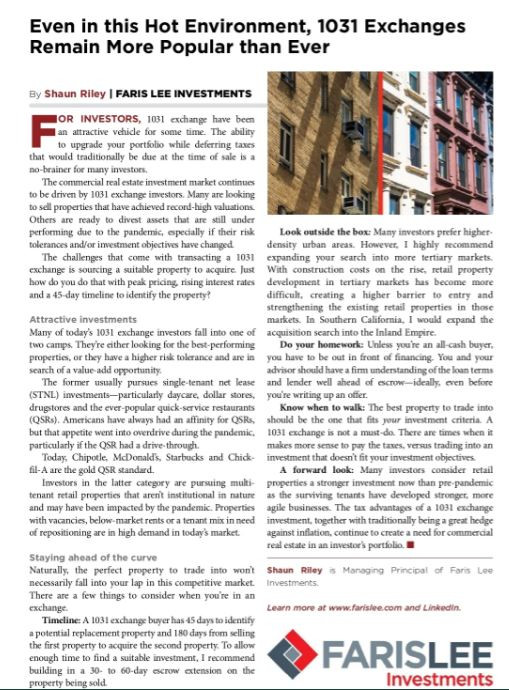FOR INVESTORS, 1031 exchange have been an attractive vehicle for some time. The ability to upgrade your portfolio while deferring taxes that would traditionally be due at the time of sale is a no-brainer for many investors.
The commercial real estate investment market continues to be driven by 1031 exchange investors. Many are looking to sell properties that have achieved record-high valuations. Others are ready to divest assets that are still under performing due to the pandemic, especially if their risk tolerances and/or investment objectives have changed.
The challenges that come with transacting a 1031 exchange is sourcing a suitable property to acquire. Just how do you do that with peak pricing, rising interest rates and a 45-day timeline to identify the property?
Attractive investments
Many of today’s 1031 exchange investors fall into one of two camps. They’re either looking for the best performing properties, or they have a higher risk tolerance and are in search of a value-add opportunity.
The former usually pursues single-tenant net lease (STNL) investments—particularly daycare, dollar stores, drugstores and the ever-popular quick-service restaurants (QSRs). Americans have always had an affinity for QSRs, but that appetite went into overdrive during the pandemic, particularly if the QSR had a drive-through.
Today, Chipotle, McDonald’s, Starbucks and Chick-fil-A are the gold QSR standard.
Investors in the latter category are pursuing multi-tenant retail properties that aren’t institutional in nature and may have been impacted by the pandemic. Properties with vacancies, below-market rents or a tenant mix in need of repositioning are in high demand in today’s market.
Staying ahead of the curve
Naturally, the perfect property to trade into won’t necessarily fall into your lap in this competitive market. There are a few things to consider when you’re in an exchange.
Timeline: A 1031 exchange buyer has 45 days to identify a potential replacement property and 180 days from selling the first property to acquire the second property. To allow enough time to find a suitable investment, I recommend building in a 30- to 60-day escrow extension on the property being sold.
Look outside the box: Many investors prefer higher-density urban areas. However, I highly recommend expanding your search into more tertiary markets. With construction costs on the rise, retail property development in tertiary markets has become more difficult, creating a higher barrier to entry and strengthening the existing retail properties in those markets. In Southern California, I would expand the acquisition search into the Inland Empire.
Do your homework: Unless you’re an all-cash buyer, you have to be out in front of financing. You and your advisor should have a firm understanding of the loan terms and lender well ahead of escrow— ideally, even before you’re writing up an offer.
Know when to walk: The best property to trade into should be the one that fits your investment criteria.
A 1031 exchange is not a must-do. There are times when it makes more sense to pay the taxes, versus trading into an investment that doesn’t fit your investment objectives.
A forward look: Many investors consider retail properties a stronger investment now than pre-pandemic as the surviving tenants have developed stronger, more agile businesses. The tax advantages of a 1031 exchange investment, together with traditionally being a great hedge against inflation, continue to create a need for commercial real estate in an investor’s portfolio.
